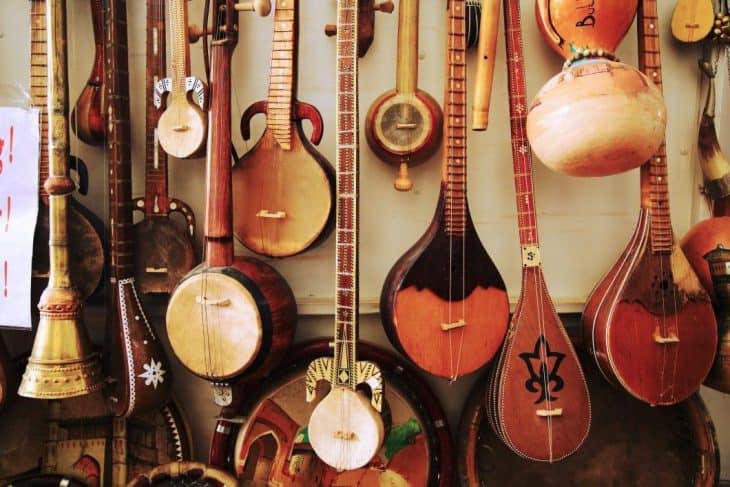
String instruments are some of the first instruments that we learn about. This is because string instruments aren’t just popular for their appearance in orchestras. You see (and hear!) them in church, in rock concerts, and even in your school’s band. There are so many string instruments out there that make such wonderful music that it can often get a bit confusing.
Of course, it gets even more confusing when the other families of musical instruments are in the picture, as they often are. But what exactly are the families of musical instruments? Musical instruments are grouped according to how they produce sounds.
While some say there are five groups in total, the four biggest ones are the brass instruments, the percussion instruments, the woodwinds, and finally, the string instruments.
What are string instruments?
Instruments that produce sound from their strings belong in the string family. Musicians will pluck, bow, or strike the strings of the instrument to make all kinds of sounds.
The string family is a big family. In fact, it is so big that it has its own subgroups: lutes, harps, and zithers. If you’re curious to learn more about the different members of the string family, including those from India, China, and other countries, then read on!
Violin

As one of the most popular orchestra instruments, the violin is easy to identify with its hollow wooden body and long bow. It is often the star of Western classical music, but it is also a popular choice for folk, country, and jazz music.
The violin usually has four strings. They produce sound when violinists draw their bows across the strings or pluck them with their fingers. Sometimes, violinists will also strike the violin strings with their bows.
Viola
The viola is easily mistaken for the violin. From afar, it might be difficult to distinguish between the viola VS the violin. However, while they look similar, the viola is slightly bigger than the violin. It is around 1 – 4 in. longer than most violins. Also, it sounds lower and deeper.
The word, “viola,” comes from the Italian phrase, “viola da braccio.” This translates to “of the arm” in English. A very fitting name for the instrument that is played with a long bow.
Cello
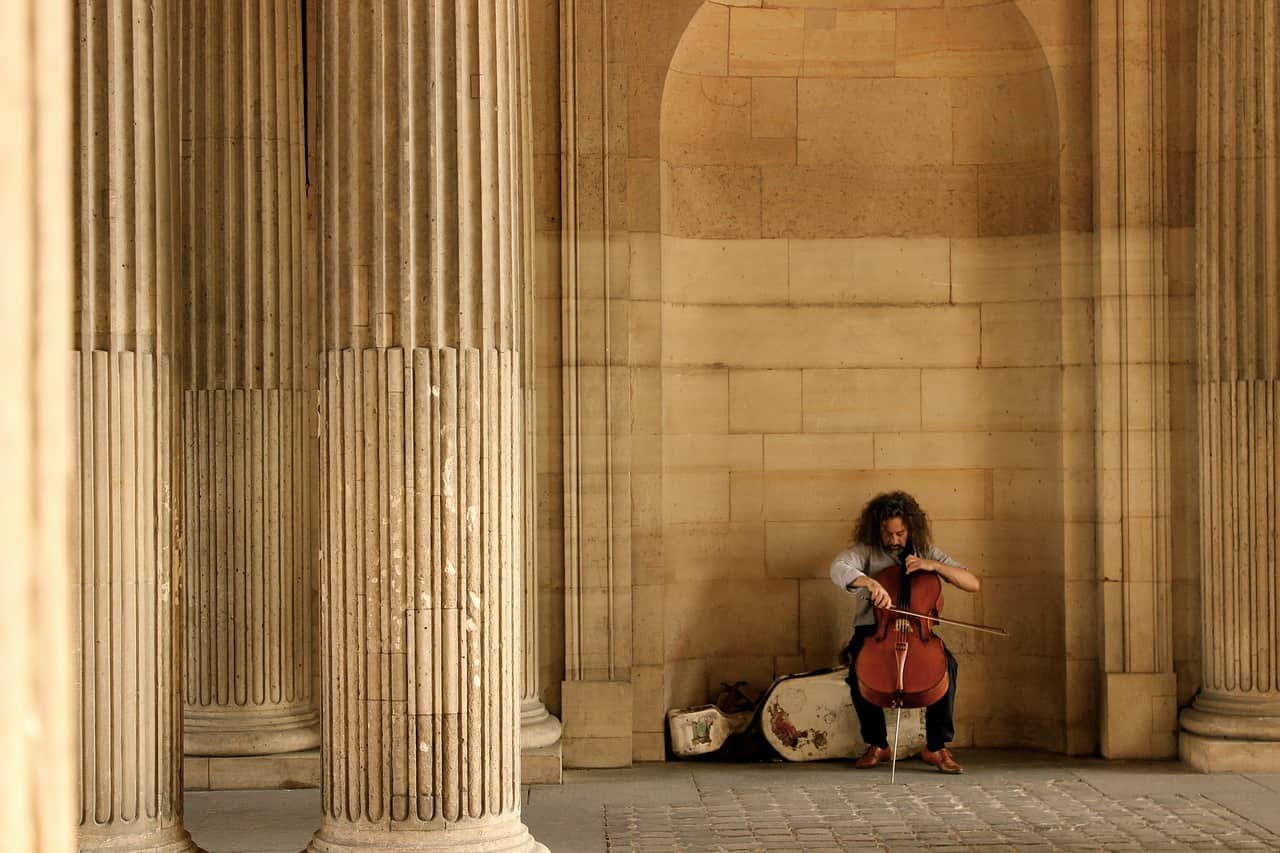
Another example of popular string instrument is the cello. The cello looks like a large violin except that it is too big to carry on the shoulder. Instead, it stands in between the musician’s legs as they play while sitting down.
Some people also call the cello the “violoncello.” Meanwhile, those who play the cello are called “cellists” or “violoncellists.”
An interesting fact about this stringed instrument is that cellos aren’t just used in orchestras. Cello rock and cello metal are subgenres of rock music. They feature the cello as its star instrument.
Bass
If you were to rank the string instruments by size, the bass, or “double bass,” is first. The bass is the largest string instrument. It is also the lowest-pitched of the violin family. You’ll often see the bass in the string section of the orchestra. Often, concertos and chamber music will also feature the bass.
This instrument is versatile. You’ll hear the cello outside of classical music. Jazz, blues, rock, and country music often use the bass. Funk and reggae also feature the bass at times.
Guitar
One of the most common string instruments is the guitar. The guitar usually has six strings. The musician holds the guitar against their body, usually with a shoulder strap. To produce sound, the musician has to pluck or strum the strings by the body while pressing them on the guitar’s fretted neck.
There are different types of guitars out there. This includes the classical guitar, which uses nylon strings, acoustic guitars, and Hawaiian guitars. The electric guitar and bass guitar are also extremely popular. They’re what you’ll often see at rock concerts.
Autoharp
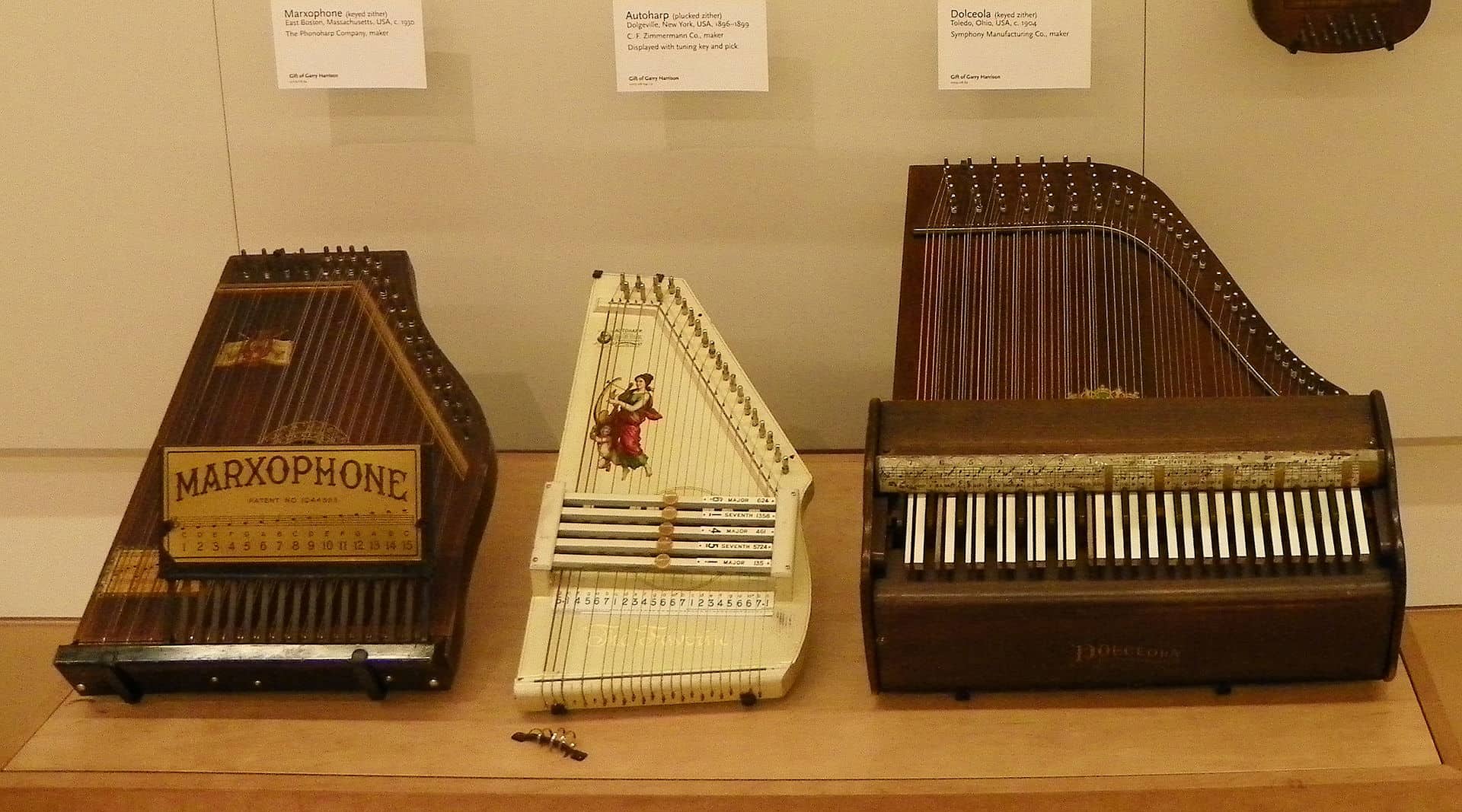
The autoharp is a member of the zither subgroup of string instruments. This instrument is less common to rock enthusiasts. However, the autoharp is a popular choice for folk and country music.
The autoharp player can use various ways to hold this stringed instrument. They can position it on a table or prop it on their left shoulder. Like guitarists, autoharp players also use a pick to strum the strings.
Banjo
Inspired by African instruments, the banjo is another popular string instrument. The banjo has five strings. The body comprises a circular frame covered by a thin plastic or animal skin. You’ll often hear the banjo in folk and country songs. Traditional music by African-Americans also features the banjo.
Around the 19th century, the banjo entered mainstream styles of music, including the rock genre. The popular rock band Led Zeppelin has featured the banjo in several songs.
Biwa
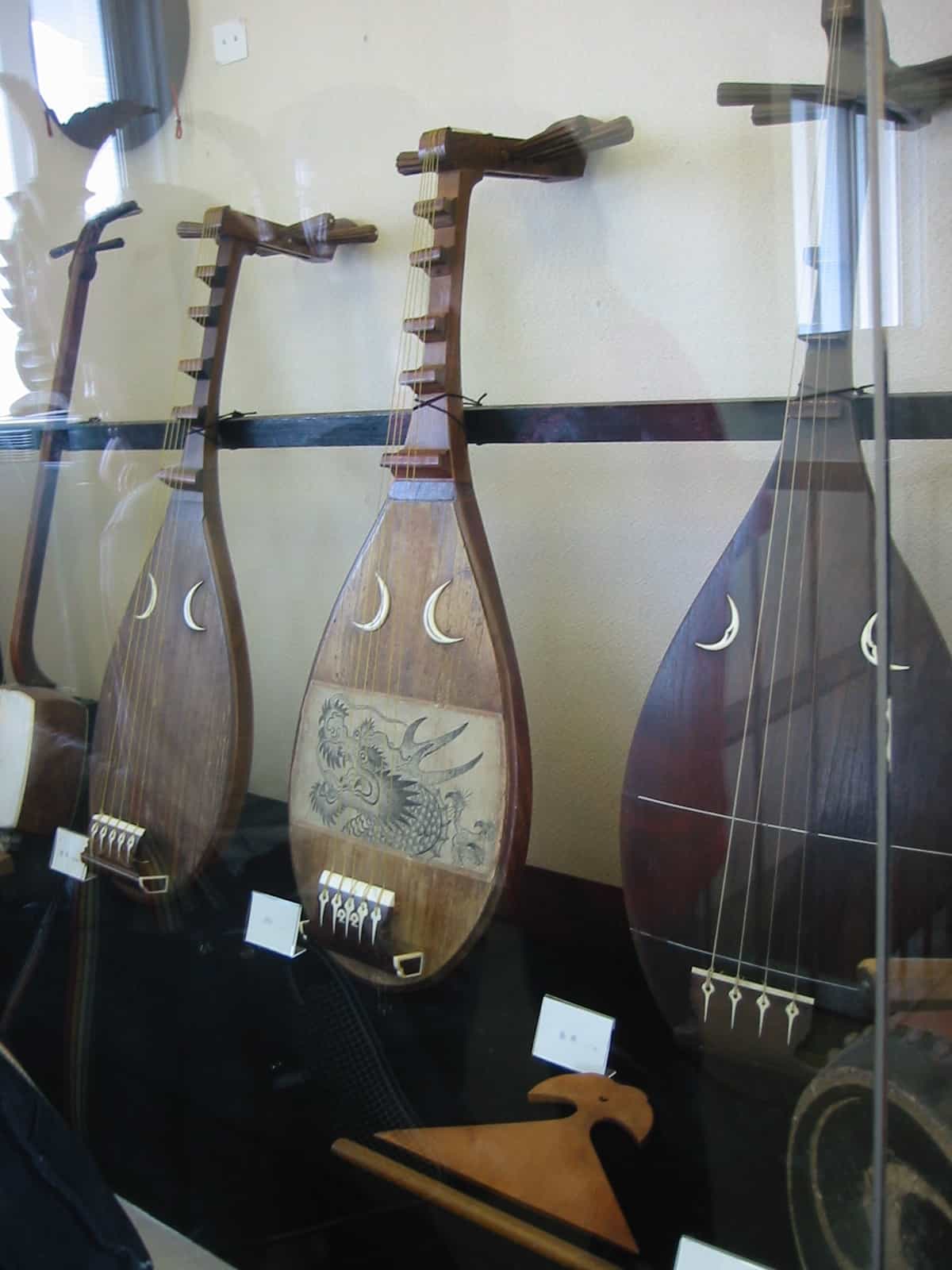
The biwa is part of the lute family of string instruments. The biwa is a Japanese traditional instrument shaped like a drop of water with a short wooden neck. Biwa players use this string instrument as an accompaniment to their storytelling. This includes scriptural texts and war epics like “The Tale of the Heike.”
The biwa is also popular in China and other countries in East Asia.
Blik Kitaar
Also known as the “ramkie guitar,” this string instrument originated from 18th century South Africa. The Khoikhoi, or indigenous people from southwestern Africa, made the early ramkie guitar from gourds. Today, a hollowed oil can, a piece of wood, and fishing wire comprise the modern version. The hollowed oil can serves as the body, and musicians will often paint it with colors of the South African flag.
Some also call this indigenous instrument the “Afri-can.”
Chinese Guqin
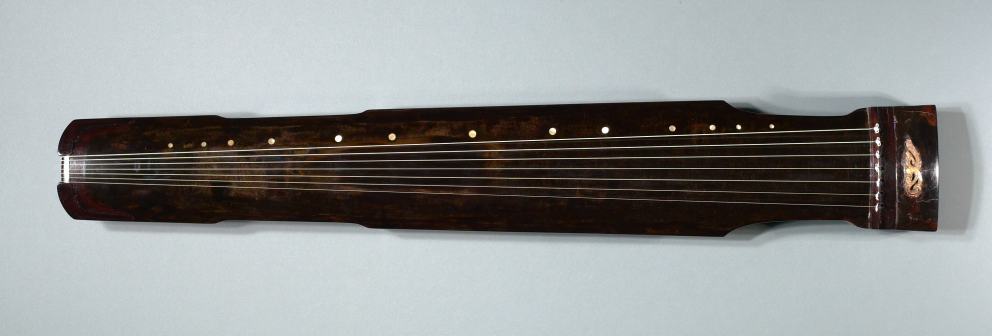
Asian string instruments have risen in popularity because of pop culture. Films and TV shows often feature the guqin.
The guqin is a Chinese string instrument. This seven-string instrument is important to Chinese culture. Traditionally, scholars associate the guqin with Confucius, the ancient Chinese philosopher. Some also refer to the guqin as “the instrument of the sages.”
Most of the time, the guqin is a solo instrument. This is because the sound it produces is very quiet, so other instruments can easily overpower its sound. Guqin players possess great technique, as it isn’t easy to learn and play.
Dotar

The dotar, or “dutar,” is only one example of the many Asian string instruments on this list. Common in Iran and Central Asia, the dotar has a pear-shaped body and a long neck with two strings. Originally, the strings were made from gut. Later on, artisans used silk and nylon for the strings.
Its play technique differs per region. In Western China, players usually pluck the dotar’s strings. In Afghanistan and Uzbekistan, players will strum and pluck their strings.
Dotara
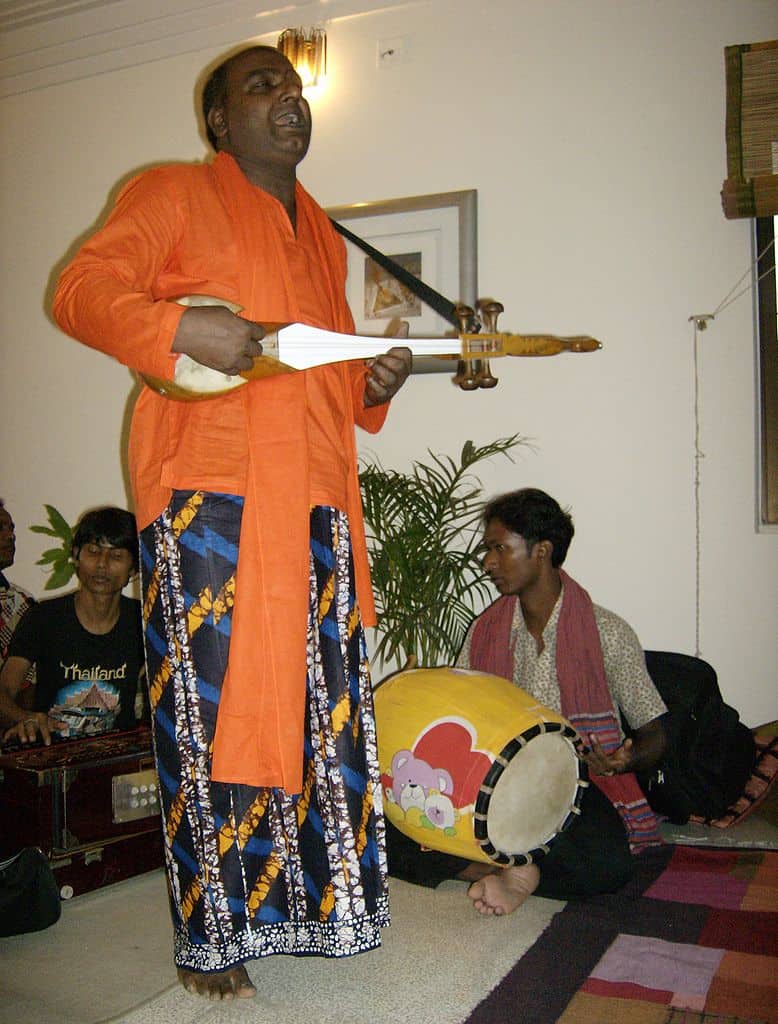
“Dotara” translates to “of or having two wires.” However, this Bengali string instrument doesn’t always have two strings. Some have four or five strings. The name comes from the two strings in the middle that have the same note.
Often, the dotara stars in Bengal and Assam folk music. Later on, groups like the Bauls and Fakirs began using the dotara.
Dulcimer
For most string instruments, the player has to use a bow, pick, or simply their fingers to strum or pluck the strings. Meanwhile, the dulcimer requires the player to use small hammers to beat the strings. The typical dulcimer is shaped like a trapezoid with metal strings stretched across its frame.
However, in the 19th century, strummed dulcimers also became popular. Other variations also arose in the 20th century. This includes banjo dulcimers, resonator dulcimers, bowed dulcimers, and electric dulcimers.
Esraj
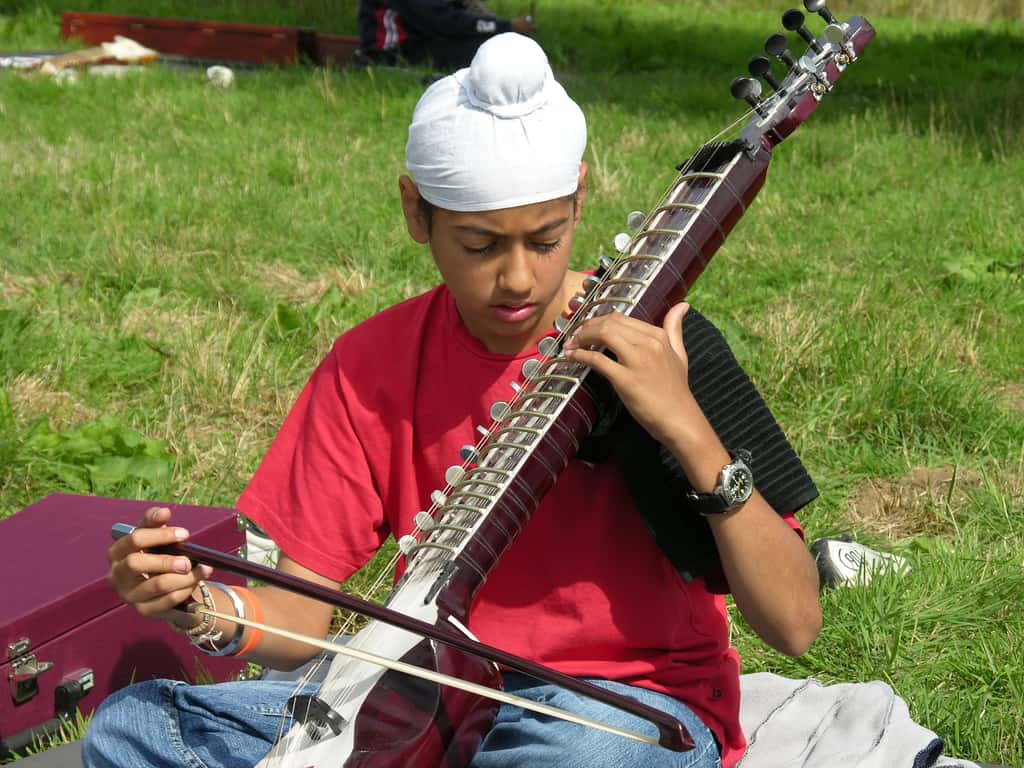
The esraj, sometimes “israj,” is one of the many string instruments from India. To play this instrument, musicians need to use a bow, like how the violin is played. Sikh music and other songs from West Bengal feature the esraj.
Despite being a relatively recent instrument, the esraj is sadly losing its popularity. It is rarely played nowadays.
Erhu
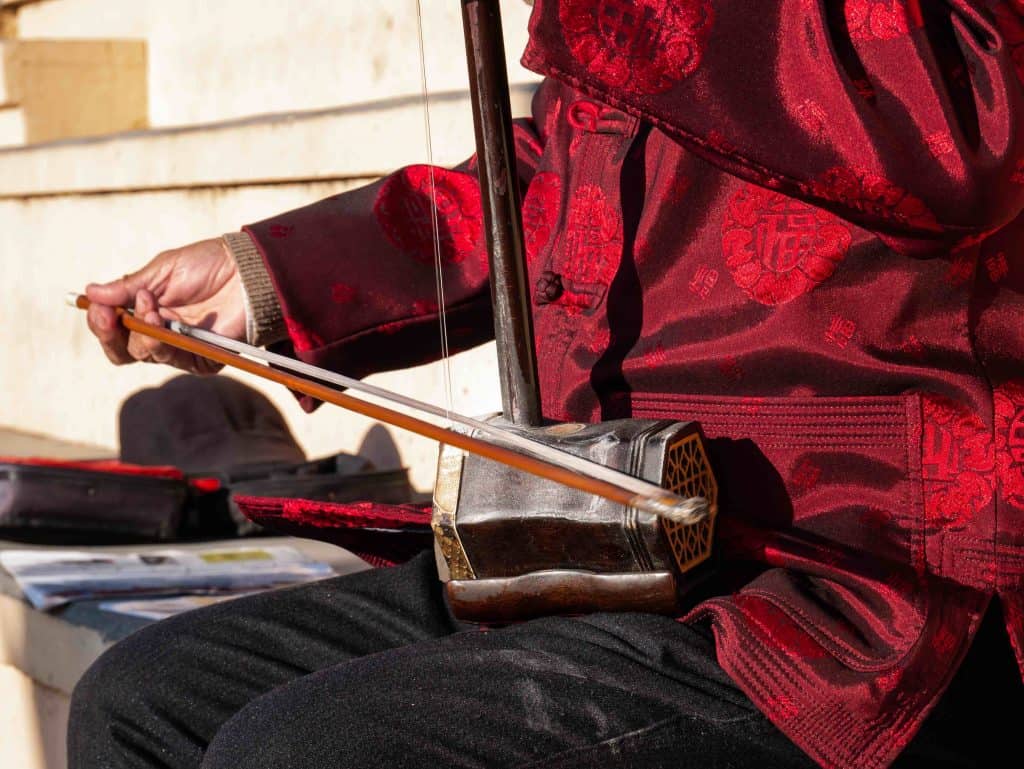
Another example of string instruments with only two strings is the erhu. Some also call the erhu as the “Chinese violin” or “Chinese two-stringed fiddle.” Various ethnic groups from China favor using the erhu, making it the most popular of their traditional bowed string instruments.
This versatile instrument can go solo or harmonize with other instruments in orchestras. Also, both traditional and modern music feature the erhu. You’ll hear the erhu in pop, rock, and jazz tracks.
Guitarron
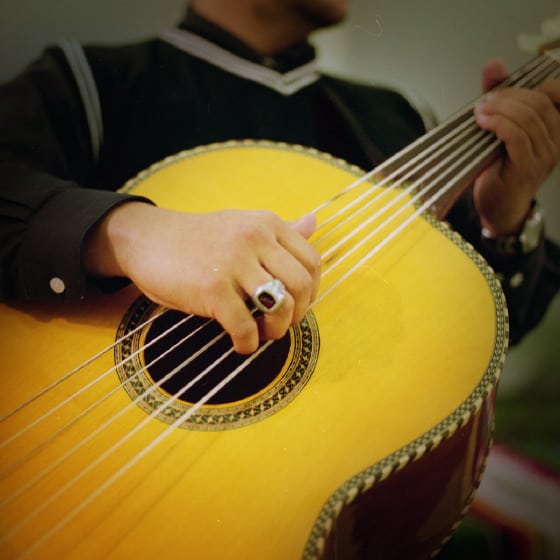
The guitarron mexicano, or “Mexican guitarron,” is an acoustic bass. This string instrument is enormous, and it has six strings. Because of its large body, the sounds it produces are loud and don’t need any electric amplifiers. Mariachi groups will often have a guitarron player among them.
Unlike the guitar, it is fretless. An interesting fact about this stringed instrument is that it inspired the creation of the acoustic bass guitar in 1972.
Gurmi
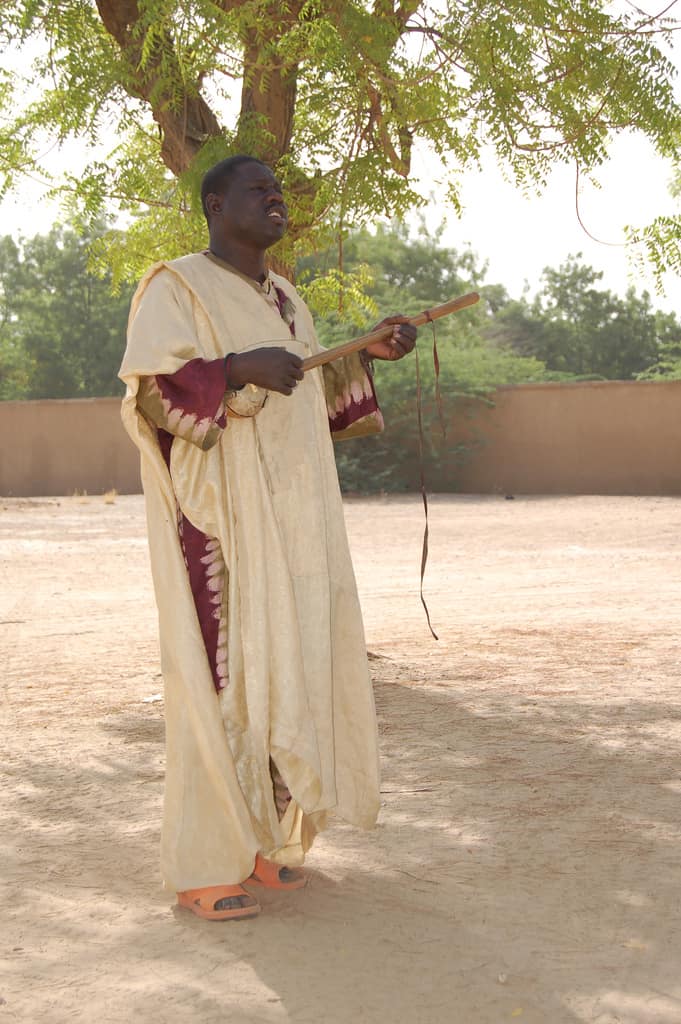
The gurmi is a traditional string instrument from northern Nigeria. Usually, the gurmi is 60 cm long and has two strings. It has a circular body and a long neck.
Harp
When talking about string instruments, it’s impossible to leave out the harp. This stringed instrument is easily distinguishable. The entire frame is triangular and usually made of wood. A pillar supports the harp’s strings at one side. Because of its tall height, you can play this instrument either standing or sitting down.
Records show that the harp was already popular in ancient Egypt, Iran, Iraq. Later on, India, China, and Europe also favored the harp.
Kemence
The kemence, or “kemenche,” is one of the Eastern Mediterranean’s bowed string instruments. It usually has three strings, and players hold it upright. The kemence’s body comes in different forms depending on its variation. The Kemence of the Black Sea is box-shaped while the classical kemence is bowl-shaped.
This traditional instrument features in folk music in Armenia, Greece, Iran, and Turkey.
Kora

Popular in west Africa, the kora is a string instrument with 21 strings. It is a hybrid of two string instruments: the lute and harp. Unlike most string instruments that use wood, the kora is made from a bottle guard cut in half and covered with leather.
Kora players pluck the strings with their fingers while the kora stands vertically on the ground.
Koto
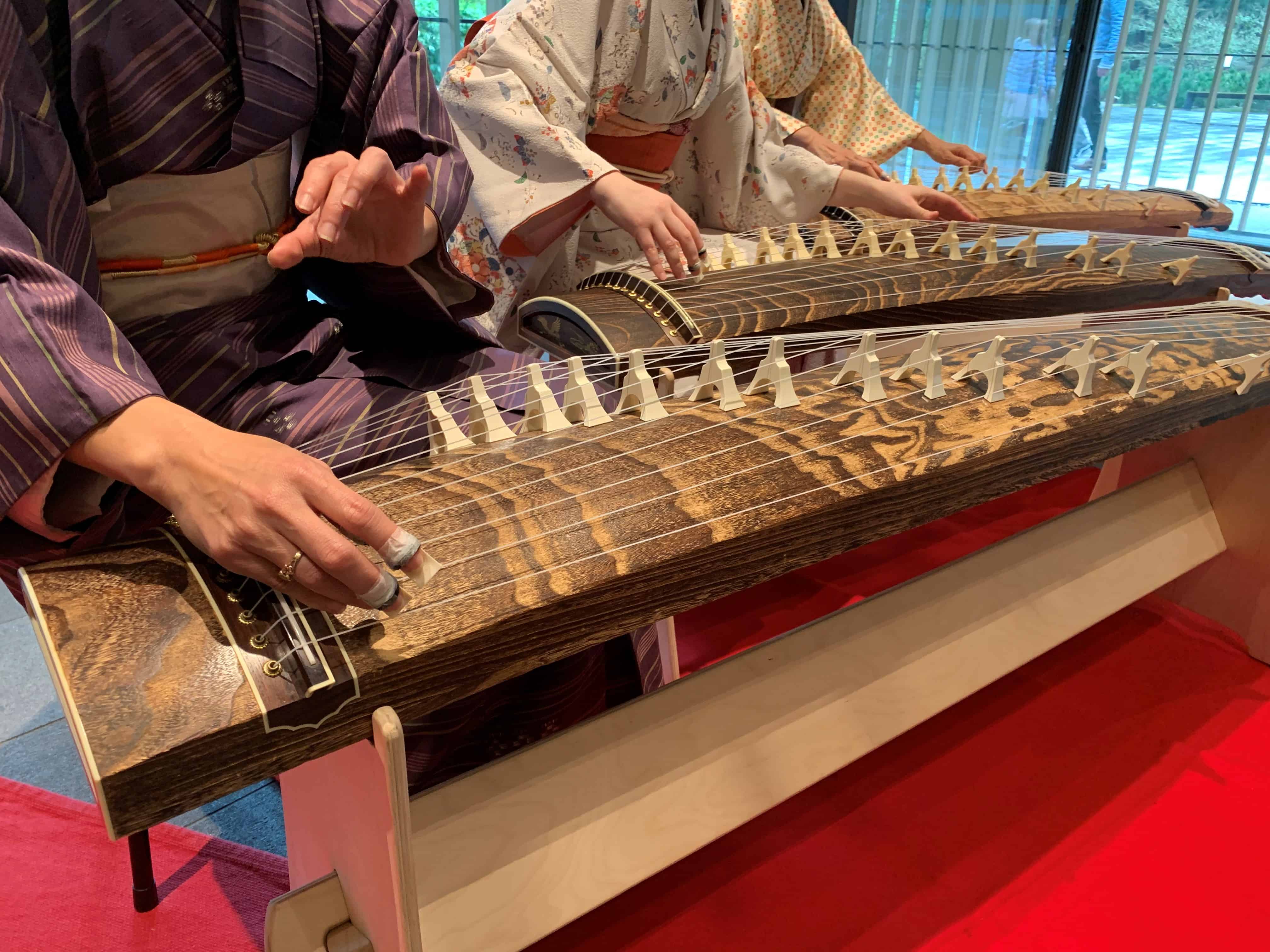
Another string instrument from Japan is the koto. In fact, the koto is Japan’s national instrument. The koto is a zither with 13 strings. The entire body is usually 71 in. long. Usually, koto players will use fingerpicks to pluck these strings. The Chinese zheng inspired the koto, so they are very similar.
Liuqin
There’s no shortage of string instruments from China, and the liuiqin is part of this list. The liuqin is relatively small with a pear-shaped body. It usually has three to five strings. This string instrument is versatile and will appear in Chinese orchestral music or stand as a solo instrument.
Liuqin players use a pick to pluck its strings, and they hold it diagonally across their chest. Some other names of the liuqin include “liyueqin” and “tu pipa.”
Lute
The lute is a subgroup within the string family. String instruments that have a neck and a round hollow cavity for its body count as lutes. This group includes different types of guitars and other traditional instruments derived from the guitar.
Lyre
If you’re a fan of Greek culture, then you’re most likely familiar with the lyre. The lyre is like the harp in many ways, but it is still unique in its own right. The lyre dates back to Ancient Greece. It has strings attached to its soundbox. Most lyres are small enough that players can easily carry and play it with their two hands while standing.
In Greek mythology, many believe Apollo created the lyre. It is one of the many symbols that represent him.
Mandolin
Under the lute family is the mandolin. Historians believe that the mandolin originated from 17th century Italy, after drawing inspiration from similar lutes like the gittern and mandore.
Most mandolins have 8 strings made from metal. Some, however, also have 10 or 12 strings. This string instrument has different variations. The round-backed mandolin, the archtop mandolin, and the flat-backed mandolin are the most common. Each creates a distinct sound that features in different genres of music as well.
Musical Bow
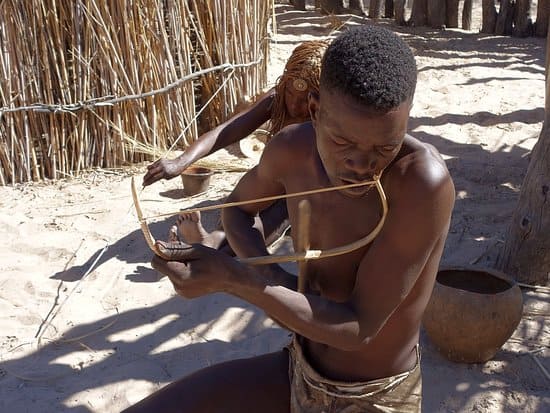
You might know this string instrument by its other names. The musical bow is also called the bowstring or string bow. This string instrument is popular in South Africa. What is so unique about this instrument is that it only has one string.
The musical bow comprises a flexible wooden stick that ranges from 1.5 to 10 ft. A long metal string is tied to each stick’s ends. Musical bow players pluck the string with their fingers or another wooden stick.
Ngoni
Another string instrument from Africa is the ngoni. The string instrument is the traditional guitar of Mali. It usually has six strings, and it has a body made of wood or gourd. You’ll often see the ngoni at African ceremonies.
Oud

As far as pear-shaped string instruments go, the oud certainly stands out with 11 strings. It has a short neck with a pear-shaped body. While most have 11 strings, some ouds also have 10 or 13 strings. In Mesopotamia, the early oud only had 3 strings. As artisans started crafting the soundbox to be bigger and bigger, the number of strings increased.
You can find the oldest surviving oud at the Museum of Musical Instruments in Brussels.
Piano
The classification of the piano can be a bit confusing. Some believe that it belongs with the other string instruments. Others believe it is part of the percussion family. This is because the piano has strings that produce music when struck with wooden hammers. Thus, some people don’t know whether the piano is actually a string instrument or a percussion instrument. However, some have settled on the idea that it is simply both.
The piano is quite popular, and this is because it is so versatile. You’ll hear the piano in almost all genres of music. It is almost always a part of the orchestra, and it can go solo without a problem as well.
Pipa
The pipa is another string instrument from China. It is a plucked musical instrument with four strings. It has a thin neck and a pear-shaped body. In fact, the pipa looks like a larger liuqin. Some also call the pipa the “Chinese lute.”
Later on, other Asian string instruments drew inspiration from the pipa. This includes the biwa from Japan, the bipa from Korea, and the dan ty ba from Vietnam.
Ravanahatha

The ravanahatha goes by many names. Some call this string instrument the “ravanhatta.” Other names include “rawanhattha,” “ravanstron,” or “ravana hasta veena.” The ravanahatha is an ancient bowed instrument from India and Sri Lanka.
The ravanahatha’s body is usually a gourd, a coconut shell, or a hollow wood cylinder. Its neck is quite long and is usually made from bamboo. It usually has four strings, but some also more or less.
Ruan
Another traditional string instrument from China is the ruan. The ruan has a fretted neck with a circular body. It has four strings. Different sizes of the ruan exist, and each size produces a different tone and sound. In Taiwan, people call this instrument “ruanqin.”
Ruan players either use a guitar pick to pluck the instrument’s strings. Some will attach acrylic nails to their fingers and use them instead of picks.
Sarinda
India has produced plenty of string instruments that continue to be used today. The sarinda is an example of this. The sarinda has many variations. Some have 10 strings, while some have up to 30 strings. Sarinda players sit on the ground and hold the sarinda in a vertical position. They use a bow to play the strings.
The sarinda holds great cultural and religious significance in India. It is used in devotional music. Several Indian ethnic groups also use the sarinda in their folk music and dance.
Sarod Kanailal
The sarod kanailal is a must-have in North India’s classical music. Also known as just “sarod,” the sarod kanailal has different types. One type has 2 strings while another has up to 23 strings. Sarod players use the plucking technique to make rich and bright sounds from this string instrument.
Setar
The setar is a traditional instrument from Persia. This stringed instrument has a long neck with four strings. Setar players use their index finger to pluck its strings. The setar’s body is pear-shaped with multiple holes to allow the sound to escape. You’ll hear the setar in Persian traditional music.
Shamisen
Japan has plenty of entries in this string instruments list. The shamisen is yet another one. Other names for this string instrument are “samisen” or “sangen.” The shamisen has different styles. Some have a thin neck, while some have longer and thicker necks. It depends on what the shamisen is used for. For instance, you’ll find shamisens in kabukis with thinner necks.
This traditional string instrument has three strings. Musicians play the shamisen with a specialized pick called the “bachi.”
Sitar
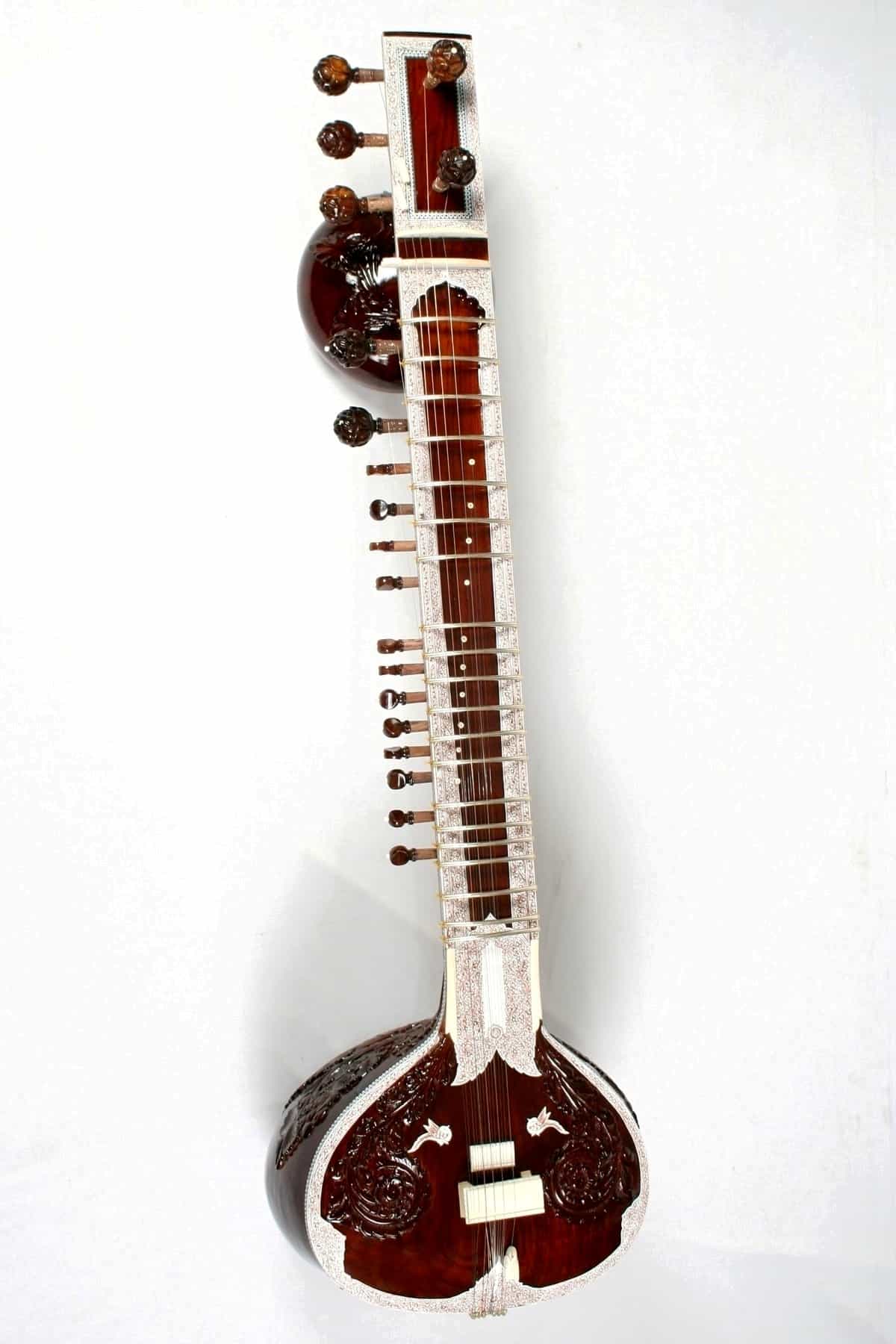
This string instrument is not to be confused with the setar. The sitar is another string instrument from India. It has a long neck with 18 to 21 strings. Its body is usually made from gourds or other kinds of wood.
To play the sitar, the musician must balance it between their left foot and right knee. They pluck the strings with a metallic pick or a mizraab. A mizraab is a type of pick for Indian string instruments.
Subrahar
The subrahar is another string instrument from the Indian subcontinent. The subrahar comes in different sizes, but they are usually over 51 inches long. Some call this the “bass sitar” because it is very similar to the sitar. The difference is that the subrahar has a lower tone. The subrahar produces sound when its strings are plucked.
Swarmandal
Indian string instruments don’t end with the subrahar. The swarmandal is yet another string instrument from Northern India. This instrument is a box zither, so it doesn’t have a neck. The strings span the length of the soundbox. It often accompanies vocals in an Indian classical music piece.
Tanbur
The tanbur is a subgroup of the string family. It comprises different string instruments from Mesopotamia, Southern Asia, and Central Asia. Tanburs are often part of Iranian, Indian, and Afghanistan traditional music.
Most tanburs have incredibly long necks. Its body or soundbox differs in sizes and shapes. It depends on where the tanbur was made. For example, the Turkish tambur has a long thin neck. It has a round body with six strings.
Tambura
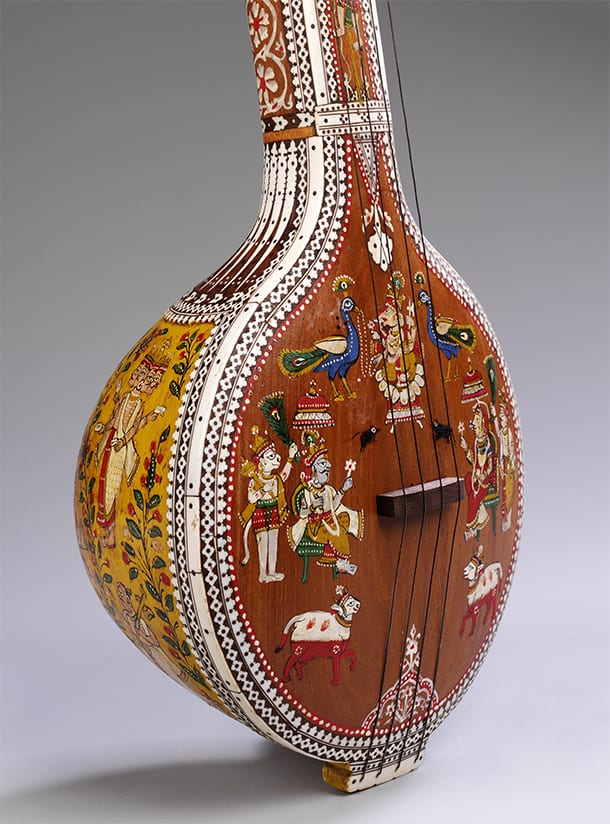
Out of all the string instruments, the tambura might be the most colorful one. The tambura, or “tanpura,” features colorful designs on its wooden body and neck. The designs feature Hindu deities and gods like Ganesha, Brahma, and Shiva. Symbolic animals such as peacocks and cows also appear. Sometimes, caricatures of musicians are also painted onto the tambura’s neck.
The tambura has four strings, and it is usually around 40 in. long. Some call the tambura’s smaller version “tamburi.”
Tar
The tar is a long-necked string instrument. The body has what looks like a waist, making it shaped like an hourglass. It has four strings that are played with a small bass pick. This string instrument is popular in Iran, Uzbekistan, and Georgia.
Tumbi
The tumbi has many names. Some call it the “toombi,” “tumba,” or “toomba.” This traditional string instrument is from India’s Punjab region. The tumbi only has one string. Thus, the sound it produces is high-pitched.
The tumbi is quite popular in Western Bhangra music and other folk songs. However, Western pop songs have also taken a liking to the tumbi. In particular, Missy Elliott’s popular track, “Get Ur Freak On,” features the tumbi’s sound.
Ukulele

The ukulele is quite popular among the string instruments on this list. This string instrument rose in popularity after it was introduced to Hawaii during the 19th century. Ukuleles vary in size, but it is relatively smaller than the guitar. Plus, it also comes in different and fun colors. It has four strings made of nylon and a fretted neck.
An interesting fact about the ukulele is that its name roughly translates to “jumping flea.”
Veena
The veena, or “vina,” is an umbrella term for string instruments from the Indian subcontinent. This includes Indian lutes, zithers, and harps. Thus, there are a lot of different types of veena. Most have long, hollow necks.
Vihuela
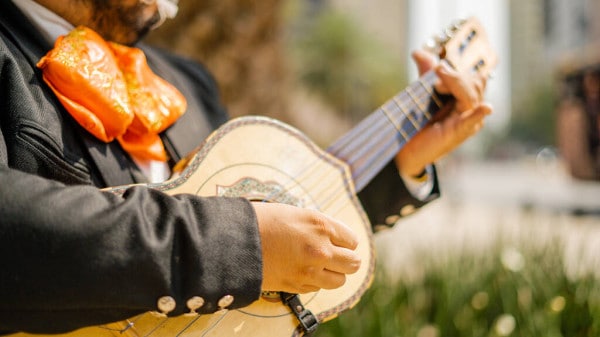
Among Spanish string instruments, the vihuela is another that looks like a guitar. This stringed instrument is from 15th century Spain. It usually has five or six double-strings. Some versions of the vihuela require a bow in order to play it. However, some can also produce music simply through the player plucking the strings with their fingers.
Xalam
The xalam is one of the many string instruments from West Africa. It has different variations. Some have only 1 string, while others have up to 5 strings. Its body is wooden and oval-shaped.
In Wolof, they call those who play this instrument “xalamkat.” Xalamkats will usually craft their own xalams, but they will also ask woodworkers to help them with the individual parts.
Yamatogoto
This string instrument has many names. Some call the yamatogoto “wagon” or “azumagoto.” These names translate to “Japanese stringed instrument.” The yamatogoto is a zither with six or seven strings. It features in a lot of Japanese myths. Thus, it is culturally significant to the Japanese people.
However, you won’t often find the yamatogoto featured in modern performances. It is only used in gagaku these days. Gagaku refers to Shinto court music.
Yangqin
The yangqin is one of the most popular Asian string instruments. This Chinese instrument is popular in Eastern Europe, the Middle East, and India.
The yangqin is a hammered dulcimer with a trapezoid shape. As a dulcimer, the instrument produces sound when the strings are hit. Most yangqins have 144 strings in total. This makes it difficult to learn and master. Other names for the yangqin include “yang quin” or “yang ch’in.”
Zheng

The zheng, or “guzheng,” is another Chinese string instrument. This zither has a wooden body that is around 64 in. long. Most zheng have 21, 25, or 26 strings. When playing this instrument, most guzheng players wear fingerpicks made from plastic, resin, or ivory.
The guzheng inspired another Asian string instrument on this list: Japan’s koto.
Was this page helpful?
Our commitment to delivering trustworthy and engaging content is at the heart of what we do. Each fact on our site is contributed by real users like you, bringing a wealth of diverse insights and information. To ensure the highest standards of accuracy and reliability, our dedicated editors meticulously review each submission. This process guarantees that the facts we share are not only fascinating but also credible. Trust in our commitment to quality and authenticity as you explore and learn with us.
